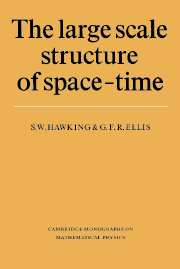Book contents
- Frontmatter
- Contents
- Preface
- 1 The role of gravity
- 2 Differential geometry
- 3 General Relativity
- 4 The physical significance of curvature
- 5 Exact solutions
- 6 Causal structure
- 7 The Cauchy problem in General Relativity
- 8 Space–time singularities
- 9 Gravitational collapse and black holes
- 10 The initial singularity in the universe
- Appendix A Translation of an essay by P. S. Laplace
- Appendix B Spherically symmetric solutions and Birkhoff's theorem
- References
- Notation
- Index
8 - Space–time singularities
Published online by Cambridge University Press: 26 January 2010
- Frontmatter
- Contents
- Preface
- 1 The role of gravity
- 2 Differential geometry
- 3 General Relativity
- 4 The physical significance of curvature
- 5 Exact solutions
- 6 Causal structure
- 7 The Cauchy problem in General Relativity
- 8 Space–time singularities
- 9 Gravitational collapse and black holes
- 10 The initial singularity in the universe
- Appendix A Translation of an essay by P. S. Laplace
- Appendix B Spherically symmetric solutions and Birkhoff's theorem
- References
- Notation
- Index
Summary
In this chapter, we use the results of chapters 4 and 6 to establish some basic results about space–time singularities. The astrophysical and cosmological implications of these results are considered in the next chapters.
In §8.1, we discuss the problem of defining singularities in space–time. We adopt b-incompleteness, a generalization of the idea of geodesic incompleteness, as an indication that singular points have been cut out of space–time, and characterize two possible ways in which b-incompleteness can be associated with some form of curvature singularity. In §8.2, four theorems are given which prove the existence of incompleteness under a wide variety of situations. In §8.3 we give Schmidt's construction of the b-boundary which represents the singular points of space–time. In §8.4 we prove that the singularities predicted by at least one of the the theorems cannot be just a discontinuity in the curvature tensor. We also show that there is not only one incomplete geodesic, but a three-parameter family of them. In §8.5 we discuss the situation in which the incomplete curves are totally or partially imprisoned in a compact region of space–time. This is shown to be related to non-Hausdorff behaviour of the b-boundary. We show that in a generic space–time, an observer travelling on one of these incomplete curves would experience infinite curvature forces. We also show that the kind of behaviour which occurs in Taub–NUT space cannot happen if there is some matter present.
- Type
- Chapter
- Information
- The Large Scale Structure of Space-Time , pp. 256 - 298Publisher: Cambridge University PressPrint publication year: 1973
- 2
- Cited by



